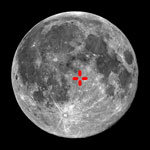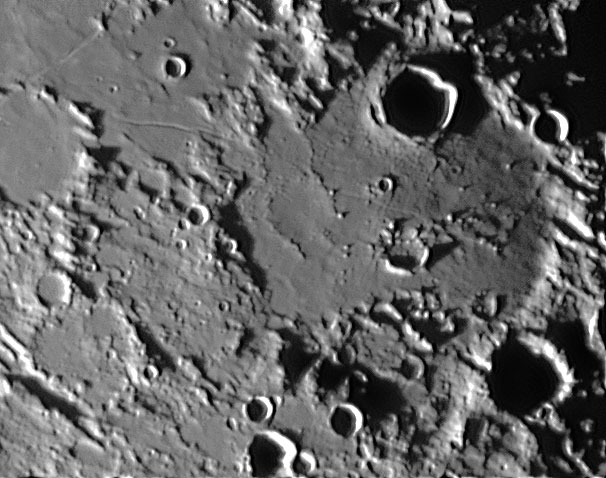|
||||||
 Hipparchus
est le reste dégradé d'un cratère de 150 Km et profond de 3320 m. Il est
situé au sud-est du Golfe central (sinus Medii), près du méridien central.
Le cratère Horrocks (30 Km, 2980m) a impacté en dessous du mur nord-est du
cratère. Le cratère Halley (36 Km, 2510 m) est lui attaché au mur Sud.
Hipparchus est un cratère antique qui a été sujet à une considérable
modification due aux impacts. Le mur occidentale d’Hipparchus est le plus
érodé et seulement des crêtes restent pour décrire le dispositif. Le
mur à l'Est est légèrement plus intact, mais aussi fortement érodé. Une
fissure profonde se situe dans le mur occidental Rima Réaumur longue de 45
km. Le plancher du cratère a été recouvert de lave. La partie sud-ouest du
plancher, cependant, est plus haute et tourmentée que le reste. Quelques
petites élévations et la muraille partielle d'un cratère inondé sont tout ce
qui reste d'un massif central. A l’Ouest du fond des cratères fantômes
subsistent. De grandes vallées parallèles semblent avoir scarifié le cratère
et son environnement, bien visibles sur le mur sud-est.
Hipparchus
est le reste dégradé d'un cratère de 150 Km et profond de 3320 m. Il est
situé au sud-est du Golfe central (sinus Medii), près du méridien central.
Le cratère Horrocks (30 Km, 2980m) a impacté en dessous du mur nord-est du
cratère. Le cratère Halley (36 Km, 2510 m) est lui attaché au mur Sud.
Hipparchus est un cratère antique qui a été sujet à une considérable
modification due aux impacts. Le mur occidentale d’Hipparchus est le plus
érodé et seulement des crêtes restent pour décrire le dispositif. Le
mur à l'Est est légèrement plus intact, mais aussi fortement érodé. Une
fissure profonde se situe dans le mur occidental Rima Réaumur longue de 45
km. Le plancher du cratère a été recouvert de lave. La partie sud-ouest du
plancher, cependant, est plus haute et tourmentée que le reste. Quelques
petites élévations et la muraille partielle d'un cratère inondé sont tout ce
qui reste d'un massif central. A l’Ouest du fond des cratères fantômes
subsistent. De grandes vallées parallèles semblent avoir scarifié le cratère
et son environnement, bien visibles sur le mur sud-est. |
||||||
|
Hipparchus is the degraded remnant of a lunar crater. It is located to the southeast of Sinus Medii, near the center of the visible Moon. To the south is the prominent Albategnius crater, and to the southwest lies Ptolemaeus crater, a feature of comparable dimensions to Hipparchus. The Horrocks crater lies entirely within the northeast rim of the crater. Halley crater is attached to the south rim, and Hind crater lies to the southeast. To the north-northeast is the bowl-shaped Pickering crater, and the flooded Saunder crater is located off the northeast rim. Hipparchus is where the Moon rocket lands in Tintin's On a marché sur la Lune (Explorers on the Moon). This feature is an ancient crater that has been subject to considerable modification due to subsequent impacts. The western rim of Hipparchus has been all but worn away from impact erosion, and only low hills and rises in the surface remain to outline the feature. The wall to the east is somewhat more intact, but it too is heavily worn. A pair of deep clefts lie in the western wall. These parallel a sets of scars running through the south-central highlands. The crater floor has been partially resurfaced by basaltic lava flow. The southwest part of the floor, however, is slightly raised and much more rugged than the remainder. A few small rises and the raised partial rim of a flooded crater are all that remain of a central massif. Gaps in the northwest rim of Hipparchus crater rim form valleys that connect with the maria to the northwest. A rille named Rima Réaumur runs from this site to the outer wall of Réaumur. |
| |||||


 (English version,
(English version,
